Harp seal
| Harp seal | |
|---|---|
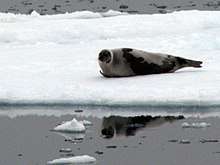 | |
| Scientific classification | |
| Kingdom: | Animalia |
| Phylum: | Chordata |
| Class: | Mammalia |
| Order: | Carnivora |
| Clade: | Pinnipedia |
| Family: | Phocidae |
| Genus: | Pagophilus Gray, 1844 |
| Species: | P. groenlandicus |
| Binomial name | |
| Pagophilus groenlandicus Erxleben, 1777 | |
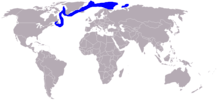 | |
| Synonyms | |
|
Phoca groenlandica | |
The harp seal or saddleback seal, Pagophilus groenlandicus is a species of earless seal, or true seal, native to the northernmost Atlantic Ocean and Arctic Ocean. Originally in the genus Phoca with a number of other species, it was reclassified into the monotypic genus Pagophilus in 1844. In Latin, its scientific name translates to "ice-lover from Greenland," and its taxonomic synonym, Phoca groenlandica translates to "Greenlandic seal."[2]
Description

The mature harp seal has pure black eyes. It has a silver-gray fur covering its body, with black harp or wishbone-shaped markings dorsally. Adult harp seals grow to be 1.7 to 2.0 m (5 ft 7 in to 6 ft 7 in) long and weigh from 115 to 140 kg (254-308 lbs).[3] The harp seal pup often has a yellow-white coat at birth due to staining from amniotic fluid, but after one to three days, the coat whitens and remains white for 2–3 weeks, until the first molt.[2] Adolescent harp seals have a silver-gray coat spotted with black.
Physiology
Harp seals are considered sexually dimorphic, as the males are slightly larger, and more decorated. Males weigh an average of 135 kg (298 lbs.), and reach a length up to 1.9 meters (6.2 ft.), while females weigh an average of 120 kg (264 lbs.) and reach up to 1.8 meters (5.9 ft.). Males generally have a more defined dorsal harp marking and a darker head, while some females never develop the marking and remain spotted.[2]
Diving
Compared to other phocid seals, the harp seal dives from shallow to moderately deep depths.[2] Dive depth varies with season, time of day and location. In the Greenland Sea sub-population, the average dive rate is around 8.3 dives per hour and dives range from a depth of less than 20 to over 500m.[4] Dive duration ranges from less than 2 minutes to just over 20 minutes.[4] During the spring and summer when seals forage along the pack ice in the Greenland Sea, most dives are less than 50m.[4] In the late fall and winter, dive depth has been found to increase, particularly in the Denmark Strait, where the mean dive depth was found to be 141m.[4]
Lactating female harp seals spend about 80% of the time in the water and 20% of the time on the fast-ice weaning or in close proximity to their pups. However, almost half of the time spent in the water is at the surface, which is well beyond what is expected to recover from their dives.[5] This behavior allows the mother harp seal to conserve energy and avoid the harsh conditions of the fast-ice while remaining in close proximity to its pup. As with most phocids, the mother harp seal requires vast amounts of energy to ensure sufficient mass transfer to the growing, weaning pup, however they still remain within their aerobic dive limit for 99% of dives.[5]
Thermoregulation
Harp seals combine anatomical and behavioral approaches to managing their body temperatures, instead of elevating their metabolic rate and energy requirements.[6] Their lower critical temperature is believed to be under -10 degrees Celsius in air.[7] Blubber insulates the Harp seals core but not the flippers as much, instead the flippers rely on having circulatory adaptations to help prevent heat loss through their flippers.[8] A thick coat of blubber insulates its body and provides energy when food is scarce or during fasting.[9] Blubber also streamlines its body for more efficient swimming. Brown fat warms blood as it returns from the body surface as well as providing energy, most importantly for newly-weaned pups.[2]
Flippers act as heat exchangers, warming or cooling the seal as needed. On ice, the seal can press its fore-flippers to its body and its hind-flippers together to reduce heat loss.[2] They can also redirect blood flow from the periphery to minimize heat loss.[9]
Senses
The harp seals' eyes are large for its body size and contain a large spherical lens, which improves its focusing ability. Its pupil is mobile to help it adapt to the intense glare of the Arctic ice. Its retina is rod-dominated and backed by a cat-like and reflective tapetum lucidum, enhancing its low light sensitivity. Its cones are most sensitive to blue-green spectra, while its rods help sense light intensity and may provide some color discrimination. Its cornea is lubricated by lacrimal glands, to protect the eye from sea water damage. The lack of tear glands to drain secretions to the nasal passages contribute to the harp seals "eye rings" on land. This can be an indication of the hydration level of the seal.[2]
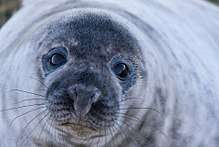
On ice, the mother identifies her offspring by smell. This sense may also warn of an approaching predator. Underwater, the seal closes its nostrils and smells nothing.[2]
Its whiskers, called vibrissae, lie in horizontal rows on either side of its snout. They provide a touch sense with labeled line coding, and underwater, also respond to low-frequency vibrations, such as movement.[2]
Diet
Similar to most pinnipeds, the harp seal exhibits a carnivorous diet.[10] They have a diverse diet which includes several dozen species of fish and invertebrates.[11] The White Sea population migrates northward in the summer to forage extensively in the Barents Sea, where common prey items include krill, capelin (Mallotus villosus), herring (Clupea harengus), flat fish and gladiform fish.[12] Harp seals are known to exhibit some preference for prey, though the driving force behind the composition of their diet is prey abundance.[13] Diet and abundance analysis of the Svalbard population found that this population feeds predominantly on krill, followed closely by polar cod(Arctogladus glacialis).[12] Some individuals from the Greenland Sea sub-population have been recorded to forage in the Barents Sea alongside the White Sea sub-population during the late summer and fall.[4] The diet of the Barents Sea population is dominated by herring and polar cod but these seals show a negative preference towards krill and amphipods, which is thought to be a result of their tendency towards deeper dives.[13] In the western N. Atlantic population segment, foraging takes place both near and offshore of Newfoundland. The most preferred prey items include Arctic cod (Boreogadus saida), capelin, Greenland halibut (Reinhardtius hippoglossoides) and American plaice (Hippoglossoides platessoides).[14] As in other populations and foraging areas, diet varies with distance from shore. Arctic cod yields a higher diet percentage nearshore, while capelin is more prominent offshore.[14] However, capelin is understood as the preferred prey item in both locales.[14]
Life history
Harp seals spend relatively little time on land compared with time at sea. These are social animals and can be quite vocal in groups. They form large colonies, within which, smaller groups with their own hierarchy are believed to form.[2] Groups of several thousand form during pupping and mating season.[15] Harp seals are able to live over 30 years in the wild.[2]
On the ice, pups call their mothers by "yelling," and "mumble" while playing with others. Adults "growl" and "warble" to warn off conspecifics and predators.[2] Underwater, adults have been recorded using more than 19 types of vocalization during courting and mating.[2]
Reproduction and Development
The harp seal is a fast ice breeder and is believed to have a promiscuous mating system.[16] Breeding occurs between mid-February and April.[15] Courtship peaks during mid-March and involves males performing underwater displays, using bubbles, vocalizations, and paw movements to court females.[17] Females, who remain on the ice, will resist copulation on unless underwater.[17]
Females mature sexually between ages five to six.[2] Annually thereafter, they may bear one pup, usually in late February.[2] The gestation period lasts about 11.5 months, with a fetal development phase of 8 months.[17] There have been reported cases of twin births, but singletons are vastly more common.[18] The fertilized egg grows into an embryo which remains suspended in the womb for up to three months before implantation, to delay birth until sufficient pack ice is available.[2]
Harp seal births are rapid, with recorded lengths as short as 15 seconds in duration.[17] In order to cope with the shock of a rapid change in environmental temperature and undeveloped blubber layers, the pup relies on solar heating, and behavioral responses such as shivering or seeking warmth in the shade or even water.[17]
Newborn pups weigh 11 kilograms (24 lbs) on average and are 80–85 centimeters (31–33 in) long.[2] After birth, the mother feeds only her own pup. During the approximately 12-day long nursing period, the mother does not hunt, and loses up to 3 kilograms (7 lb) per day.[2] Harp seal milk initially contains 25% fat (this number increases to 40% by weaning as the mother fasts) and pups gain over 2.2 kilograms (4.9 lb) per day while nursing, quickly thickening their blubber layer.[17] During this time, the juvenile's "greycoat" grows in beneath the white neonatal coat, and the pup increases its weight to 36 kg (80 lbs). Weaning is abrupt; the mother turns from nursing to promiscuous mating, leaving the pup behind on the ice. While courtship starts on the ice, mating usually takes place in the water.
After abandonment, in the post-weaning phase, the pup becomes sedentary to conserve body fat. Within a few days, it sheds its white coat, reaching the "beater" stage.[2] This name comes from the sound a beater's tail makes as the seal learns to swim.[18] Pups begin to feed on at 4 weeks of age, but still draw on internal sources, relying first on stored energy in the body core rather than blubber.[17] During this time the ice begins to melt leaving them vulnerable to polar bears and other predators. This fast can reduce their weight up to 50%. As many as 30% of pups die during their first year, due in part to their early immobility on land.[2]
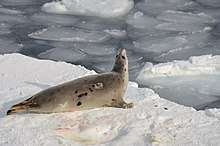
Around 13–14 months old, the pup molts again, becoming a "bedlamer".[18] Juveniles molt several times, producing a "spotted harp", before the adults' harp-marked pelt fully emerges after several years (or not at all in females).[2]
Seals congregate annually on the ice to molt, pup and breed before migrating to summer feeding grounds. Their lifespan can be over 30 years.[2]
Distribution
The current global harp seal population estimates total around 2.25 to 3 million individuals, with 3 distinct breeding stocks: 500,000-800,000 individuals in the Northeast Atlantic, 100,000-150,000 in the Greenland Sea, and 1-1.57 million in the Northwest Atlantic.[17] The largest population in the Northwest Atlantic is estimated to produce 250,000-400,000 young annually.[17] Due to their dependence on pack ice for breeding, the harp seal range is restricted to areas where pack ice forms seasonally.[2] The western North Atlantic stock, which is the largest, is located off eastern Canada.[18] This population is further divided into two separate herds based on the breeding location. The Front herd breeds off the coast of Labrador and Newfoundland, and the Gulf herd breeds near the Magdalen Islands in the middle of the Gulf of St. Lawrence. A second stock breeds on the "West Ice" off eastern Greenland. A third stock breeds on the "East Ice" in the White Sea, which is off the north coast of Russia below the Barents ea. Breeding occurs between mid-February and April, and varies somewhat for each stock.[15] The three stocks are allopatric and don't interbreed.[19]
There are two recognised subspecies:[19]
- Pagophilus groenlandicus groenlandicus – Eastern Canada to Norway
- Pagophilus groenlandicus oceanicus – White and Barents seas
Migration and vagrancy
Harp seals are strongly migratory. The northwest population regularly moves up to 4,000 kilometres (2,500 mi) northeast outside of the breeding season;[20] one individual was located off the north Norwegian coast, 4,640 kilometres (2,880 mi) east northeast of its tagging location.[21] Their navigational accuracy is high, with good eyesight an important factor.[20][22] They are occasionally found as vagrants, south of their normal range. In Great Britain, a total of 31 vagrants were recorded between 1800 and 1988,[23]
More recently, they reached Lindisfarne in Northumberland in September 1995,[24] and the Shetland Islands in 1987. The latter was linked to a mass movement of harp seals into Norwegian waters; by mid-February 1987, 24,000 were reported drowned in fishing nets and perhaps 30,000,000 (about 10% of the world population) had invaded fjords as far south as Oslo. The animals were emaciated, likely due to humans competing for their prey.[25]
Harp seals can strand on Atlantic coasts, often in warmer months, due to dehydration and parasite load.[26] Harp seals often consume snow to stay hydrated, but in mild winters may not have enough available. Several centers are active in seal rescue and rehabilitation, including IFAW, NOAA, and the New England Aquarium. Harp seals are protected by the Marine Mammal Protection Act in the United States.
Seal hunting
All 3 populations are hunted commercially, mainly by Canada, Norway, Russia and Greenland.[27]
In Canada, commercial hunting season is from November 15 to May 15. Most sealing occurs in late March in the Gulf of St. Lawrence, and during the first or second week of April off Newfoundland, in an area known as "the Front". This peak spring period is generally what is referred to as the "Canadian seal hunt". Hunting Canadian whitecoats has been banned since 1987. Since 2000, harp seals that are targeted during the hunt are often found to be less than a year old, known as "beaters".[28] In 2006, the St. Lawrence hunt officially started on March 25 due to thin ice caused by the year's milder temperatures. Inuit people living in the region hunt mainly for food and, to a lesser extent, commerce.[27]
In 2003, the three-year quota granted by the Department of Fisheries and Oceans was increased to 975,000, with a maximum of 350,000 in any two consecutive years. In 2006, 325,000 harp seals, as well as 10,000 hooded seals and 10,400 grey seals were killed. An additional 10,000 animals are allocated to First Nations hunters.
In 2005, the Independent Veterinarians' Working Group (IVWG) recommended a three-step process for hunters to kill the seals with little or no pain for the seals, as long as the process is completed in rapid succession.[28] The process is as followed:
- Stun the seal on the head using tools, such as a rifle or a club, to immediately kill the animal or cause it to permanently lose consciousness.
- Ensure that step 1 was completed correctly, and the skull is irreversibly damaged.
- Cut the axillary arteries along both armpits and cut along the belly to prevent blood from reaching the brain, confirming its death.
In 2009, this process was included in both the 'Conditions of License' for the Canadian hunt as well as the Canadian Marine Mammal Regulations.[28]
The Canadian seal hunt is monitored by the Canadian government. Although approximately 70% of the hunt occurs on "the Front", most private monitors focus on the St. Lawrence hunt, due to its more convenient location.
About 70,000–90,000 animals are taken from the population off the coast of Greenland.[27]
The 2004 West Ice total allowable catch (TAC) was 15,000, almost double the sustainable catch of 8,200. Actual catches were 9,895 in 2004 and 5,808 in 2005.[27] The 2004 White Sea TAC was 45,000. The catch was 22,474.[27]
Population Dynamics
Hunting has had a significant impact on the population size of Harp Seals. Its estimated there was 9 million Harp Seals 150 years ago, and now about 3 million remain. Hunting restrictions are now in place for these animals[29] As of the year 1994 there was approximately 4.8 million Harp Seals.[30] The Northwest Atlantic populations was found to have decreased by at least 50 percent form the time period 1952-1970's.[31] Populations have also been changing with respect to distribution and have been found to have invaded areas such as North Norway.[32] The Harp Seal invasions have been harming the areas fisheries.[33]
References
- ↑ Kovacs, K.M. (2015). Pagophilus groenlandicus. The IUCN Red List of Threatened Species doi:10.2305/IUCN.UK.2015-4.RLTS.T41671A45231087.en
- 1 2 3 4 5 6 7 8 9 10 11 12 13 14 15 16 17 18 19 20 21 22 23 Encyclopedia of marine mammals. Perrin, William F., Würsig, Bernd G., Thewissen, J. G. M. (2nd ed.). Amsterdam: Elsevier/Academic Press. 2009. ISBN 9780123735539. OCLC 316226747.
- ↑ Kovacs, K.M. 2015. Pagophilus groenlandicus. The IUCN Red List of Threatened Species 2015: e.T41671A45231087. http://dx.doi.org/10.2305/IUCN.UK.2015-4.RLTS.T41671A45231087.en. Downloaded on 03 April 2018.
- 1 2 3 4 5 Folkow, L.P.; Nordøy, E.S. (2004). "Distribution and diving behaviour of harp seals (Pagophilus groenlandicus) from the Greenland Sea stock". Polar Biology. 27: 281–298.
- 1 2 Lydersen, Christian, and Kit M. Kovacs. “Diving Behaviour of Lactating Harp Seal, Phoca Groenlandica, Females from the Gulf of St Lawrence, Canada.” Animal Behaviour, vol. 46, no. 6, Dec. 1993, pp. 1213–1221. Elsevier, doi:10.1006/anbe.1993.1312.
- ↑ Lavigne, D., Innes, S., Worthy, G., Kovacs, K., Schmitz, O., & Hickie, J. (1986). Metabolic rates of seals and whales. Canadian Journal of Zoology, 64(2), 279-284.
- ↑ Boily, Patrice; Lavigne, David M. (February 1996). "Thermoregulation of juvenile grey seals, Halichoerus grypus, in air". Canadian Journal of Zoology. 74 (2): 201–208. doi:10.1139/z96-025. ISSN 0008-4301.
- ↑ KVADSHEIM, P.H.; FOLKOW, L.P. (October 1997). "Blubber and flipper heat transfer in harp seals". Acta Physiologica Scandinavica. 161 (3): 385–395. doi:10.1046/j.1365-201x.1997.00235.x. ISSN 0001-6772.
- 1 2 "Adaptation of the Harp Seal". bioweb.uwlax.edu. Retrieved 2018-04-03.
- ↑ "Harp Seal | National Geographic". 2011-03-10. Retrieved 2018-04-10.
- ↑ "Harp Seal". Oceana. Retrieved 2018-04-10.
- 1 2 Lindstrøm, Ulf; Nilssen, Kjell (2013). "Harp seal foraging behaviour during summer around Svalbard in the northern Barents Sea: diet composition and the selection of prey". Polar Biology. 36: 305–320.
- 1 2 U. Lindstrøm, A. Harbitz, T. Haug, K. T. Nilssen; Do harp seals Phoca groenlandica exhibit particular prey preferences?, ICES Journal of Marine Science, Volume 55, Issue 5, 1 October 1998, Pages 941–953, https://doi.org/10.1006/jmsc.1998.0367
- 1 2 3 John, Lawson; Anderson, John (1998). "Selective foraging by harp seals Phoca groenlandica in nearshore and offshore waters of Newfoundland, 1993 and 1994". Marine Ecology Progress Series. 163: 1–10.
- 1 2 3 Fisheries, NOAA. "Harp Seal (Pagophilus groenlandicus) :: NOAA Fisheries". www.nmfs.noaa.gov. Retrieved 2018-04-03.
- ↑ Miller, Edward H. and Burton, Lauren E. (2001). "It's all relative: allometry and variation in the baculum (os penis) of the harp seal, Pagophilus groenlandicus (Carnivora: Phocidae)" (PDF). Biological Journal of the Linnean Society. 72 (3): 345–355. doi:10.1111/j.1095-8312.2001.tb01322.x.
- 1 2 3 4 5 6 7 8 9 Ronald, K, and J. L. Dougan. “The Ice Lover: Biology of the Harp Seal (Phoca Groenlandica).” Science, vol. 215, no. 4535, 1982, pp. 928–933. JSTOR, JSTOR, www.jstor.org/stable/1688319.
- 1 2 3 4 "Harp seal | mammal". Encyclopedia Britannica. Retrieved 2018-04-03.
- 1 2 BERTA, Annalisa; CHURCHILL, Morgan (2012-07-01). "Pinniped taxonomy: review of currently recognized species and subspecies, and evidence used for their description". Mammal Review. 42 (3): 207–234. doi:10.1111/j.1365-2907.2011.00193.x. ISSN 1365-2907.
- 1 2 Ronald, K., & Healey, P. J. (1981). Harp Seal. Chapter 3 in Ridgeway, S. H., & Harrison, R. J., eds. Handbook of Marine Mammals, vol. 2 Seals. Academic Press, London.
- ↑ Sergeant, D.E. (1973). "Transatlantic migration of a Harp Seal, Pagophilus groenlandicus". Journal of the Fisheries Research Board of Canada. 30: 124–125. doi:10.1139/f73-020.
- ↑ King, J. E. (2015). Seals of the World, 2nd. ed. British Museum, London.
- ↑ Corbet, G. B., & Harris, S., eds. (1991). The Handbook of British Mammals. 3rd ed. Blackwell, Oxford.
- ↑ Frankis, M. P.; Davey, P. R. & Anderson, G. Q. A. (1997). "Harp Seal: a new mammal for the Northumberland fauna". Trans. Nat. Hist. Soc. Northumbria. 57 (4): 239–241.
- ↑ Anon (1987). "Harp Seals, Brunnich's Guillemots and White-billed Divers". Twitching. 1 (3): 58.
- ↑ "Rounds Notes | National Marine Life Center". nmlc.org. Retrieved 2018-04-10.
- 1 2 3 4 5 Lavigne, David M. (2009). Perrin, William F.; Wursig, Bernd; Thewissen, J.G.M., eds. Encyclopedia of Marine Mammals (2nd ed.). 30 Corporate Drive, Burlington Ma. 01803: Academic Press. ISBN 978-0-12-373553-9. Archived from the original on 2009-11-09. Retrieved 2010-01-26.
- 1 2 3 Daoust, P-Y; Caraguel, C (2012-11-01). "The Canadian harp seal hunt: observations on the effectiveness of procedures to avoid poor animal welfare outcomes". Animal Welfare. 21 (4): 445–455. doi:10.7120/09627286.21.4.445. ISSN 0962-7286.
- ↑ "History and present status of populations of harp and hooded seals". Biological Conservation. 10 (2): 95–118. 1976-09-01. doi:10.1016/0006-3207(76)90055-0. ISSN 0006-3207.
- ↑ Shelton, P.A.; Stenson, G.B.; Sjare, B.; Warren, W.G. (1997). "Model estimates of harp seal numbers-at-age for the northwest Atlantic". Oceanographic Literature Review. 7 (44). ISSN 0967-0653.
- ↑ "Canadian Science Publishing". doi:10.1139/f81-071#.wxmttegvziu.
- ↑ Haug, T.; Kroyer, A. B.; Nilssen, K. T.; Ugland, K. I.; Aspholm, P. E. (1991-11-01). "Harp seal (Phoca groenlandica) invasions in Norwegian coastal waters: age composition and feeding habits". ICES Journal of Marine Science. 48 (3): 363–371. doi:10.1093/icesjms/48.3.363. ISSN 1054-3139.
- ↑ "Ecological implications of harp seal Phoca groenlandica invasions in northern Norway". Developments in Marine Biology. 4: 545–556. 1995-01-01. doi:10.1016/S0163-6995(06)80053-3. ISSN 0163-6995.
Further reading
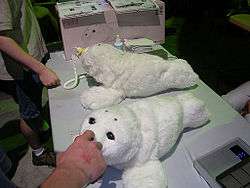
The Northwest population:
- Hammill, M.O. and Stenson, G.B., (2000). Estimated Prey Consumption by Harp seals (Phoca groenlandica), Hooded seals (Cystophora cristata), Grey seals (Halichoerus grypus) and Harbour seals (Phoca vitulina) in Atlantic Canada. J. Northw. Atl. Fish. Sci., Vol. 26:1–23
- Lawson, J.W., Anderson, J.T., Dalley, E.L. and Stenson, G.B. (1998). Selective foraging by harp seals Phoca groenlandica in nearshore and offshore waters of Newfoundland, 1993 and 1994. Marine Ecology Progress Series 163:1–10.
- Shelton, P.A. and Healey, B.P. (1999). Should depensation be dismissed as a possible explanation for the lack of recovery of the northern cod (Gadus morhua) stock? Can. J. Fish. Aquat. Sci. 56:1521–1524.
- Stenson, G.B., Hammill, M.O., and Lawson, J.W. (1997). Predation by Harp Seals in Atlantic Canada: Preliminary Consumption Estimates for Arctic Cod, Capelin and Atlantic Cod. J. Northw. Atl. Fish. Sci. 22:137–154
The White Sea and West Ice populations:
- Hamre, J.(1994). Biodiversity and exploitation of the main fish stocks in the Norwegian- Barents Sea ecosystem. Biodiversity and Conservation 3:473–492.
- Haug, T., Kroeyer, A.B., Nilssen, K.T., Ugland, K.I. and Aspholm, P.E., (1991). Harp seal (Phoca groenlandica ) invasions in Norwegian coastal waters: Age composition and feeding habits. ICES journal of marine science. 48(3):363–371
- ICES 2001. Report of the Joint ICES/NAFO Working Group on Harp and Hooded Seals, ICES Headquarters, 2–6 October 2000. ICES CM, 2001, ACFM:8, 40 pp.
- Nilssen, K.T., Pedersen, O.-P., Folkow, L.P., & Haug. T. (2000). Food consumption estimates of Barents Sea harp seals. NAMMCO Sci. Publ. 2:9–28.
